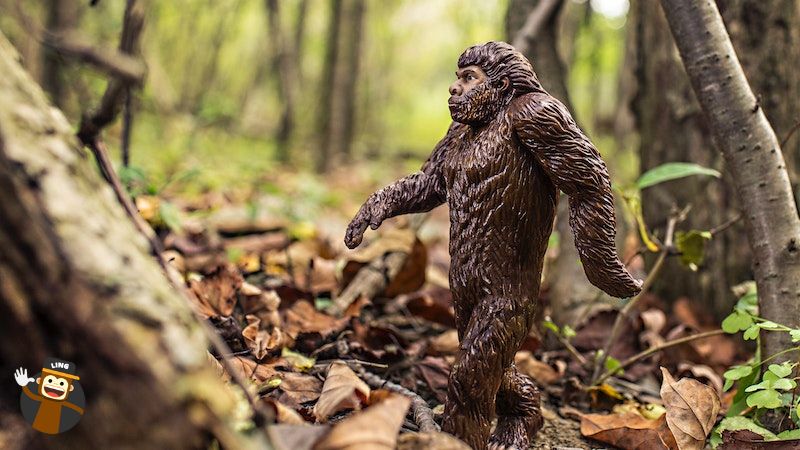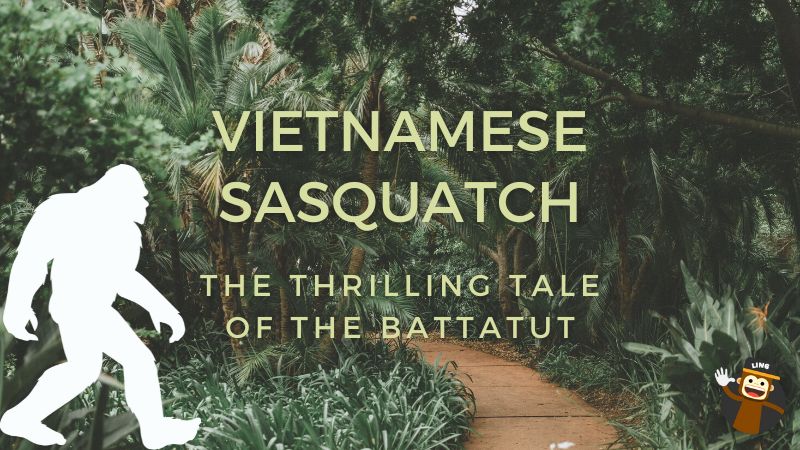Deep in the wilds of the Vũ Quang nature reserve in Central Vietnam, the local people speak of a mysterious half man, half ape-like creature. To them, it’s known as the Người rừng or forest man. To French colonists who explored the area, it was known as L’Homme Sauvage (wild man). The American G.I.s who engaged the creature in active combat called it the Batatut.
This article is brought to you by Ling. If you’re thinking about sharpening up your Vietnamese skills, Ling is the number 1 app on the market for lesser spoken languages. Come on over now.
N.B.: We also have a list of rare animal names in Vietnamese at the end if you want to skip ahead.
Batatut: The Vietnamese Sasquatch
Context
The Vu Quang nature reserve was the scene of fierce fighting during the Vietnam War (1963-1975). The Amerian G.I.s were tasked with fighting a guerilla enemy (no, not that type of gorilla) who would launch sneak attacks before blending back into the jungle. They had forward operating bases, but often these were little more than islands in a sea of foliage; foliage that harbored flesh-eating ants, snakes as thick as your thigh, and perhaps something undiscovered by modern science.
What Happened When American Soldiers Came In Contact With The Batatut?
One American G.I. at the time describes a scene in which a section of his platoon was tasked with hunting down Viet Cong deep in the wilderness.
Contact was made, and a firefight ensued. Bullets whizzed overhead, shredding the vegetation and chewing up the bark of the centuries-old banyan trees.
The deafening roar stopped, and there was a rustling from a bamboo grove nearby. The American G.I.s fixed their bayonets. It would not be unlike the Viet Cong to mount a head-on assault. The so-called human wave attacks made them some of the most feared fighters in the world.
But what emerged from the undergrowth did not look Viet Cong; in fact, it didn’t even look human.
The G.I.s reported that the creature was around 6ft tall, heavily muscled, and covered head to toe in reddish/brown hair. It walked upright, or rather bounded on its hind legs, like a person but moving faster than even the best trained Olympic athletes.
Next, came screams of terror from the silent enemy. The Viet Cong were usually like ghosts, but now the ghosts of the forest had seen something that even terrified them.

The Americans laid low until the screaming stopped and then advanced slowly on the Viet Cong position. They came across a soldier torn completely in half, an injury no bullet could have caused. It looked far more like an encounter someone might have with a grizzly bear.
The soldiers returned to base, and only then did they learn that they were not the only people to have encountered such a creature. Previous soldiers in the area had called them ‘rock apes’ for the way they’d throw stones at soldiers, friendly or enemy alike.
Sightings of the rock ape or Battaut were spread out all over Asia. And, of course, they had a striking similarity to sasquatch, or bigfoot, the ape-like creature that has become legendary in North America.
What Is Bigfoot/Sasquatch? How Is It Different From The Batatut?
The terms bigfoot and sasquatch are used interchangeably to describe a giant half man/half ape-like creature that resides in the Pacific Northwest.
The study of semi-mythical creatures is known as cryptozoology. It includes everything from the Loch Ness Monster to Chupacabra, the vampiric lizard creature that purportedly haunts farms in Latin America.
The evidence of bigfoot is sketchy but no less compelling. The most famous film of a recorded Bigfoot is the Patterson-Gimlin footage in 1967, which purports to show the creature walking across a forest trail before glancing anxiously back at the camera. Perhaps the most solid evidence can be found in various casts of giant footprints worldwide.
There are significant differences between the appearance and the behavior of Bigfoot and the Batatut. Although both creatures walk upright, Bigfoot is said to be much bigger, with some estimates up to 9ft tall. Although the Batatut encounter we discussed earlier marked the creature around 6ft tall, subsequent sightings put it around 5ft, much the same size as an orangutan leading many skeptics to say perhaps that is what the soldiers in the forest saw (more on that later).
There is also the behavior of the creatures. Bigfoot is extremely reclusive and shies away from human contact, whereas the Batatut is outright aggressive when humans enter its territory. Bigfoot also travels alone, whereas sightings of the rock apes place them in families or even tribes banding together to drive away invaders.

What Does The Science Say About A Big Foot-Like Creature?
That animals like the bigfoot once existed isn’t debatable. Scientists have found fossils of a creature named Gigantopithecus, which lived around 300,000 years ago, rather intriguingly in the forests of Southeast Asia. This creature dwarfs the biggest of humans and even the biggest of gorillas.
Around 10ft tall, and weighing 500kg, this ape would have made easy work of any tiger that it came across. That being said, it would have only killed a tiger or rhino in self-defense. Analysis of its teeth shows that it was most likely a vegetarian, feeding on forest fruits or the tough fibrous bamboo that is a jungle staple.
Throughout history, there have been many creatures resembling modern humans. Three hundred thousand years ago, there were nine human-like species all co-existing at the same time! The most famous are the neanderthals, which went extinct about 40,000 years ago. A lot of modern Europeans actually still share neanderthal DNA.
Another fascinating example of these primitive men is Homo Floriensis, a species long thought to be a myth until modern science confirmed their existence.
These creatures are descended from Homo Erectus and made a home on the island of Flores, where evolutionary pressure meant that they significantly reduced in stature (about three and a half feet tall). Some scientists affectionately know them as ‘Littlefoot’. Homo Floriensis is thought to have gone extinct about 40,000 years ago.
However, is it possible that these jungle people are long-lost cousins still thriving in unspoiled parts of the world?
What Are Some Alternative Explanations For What The Batatut Could Be?
Skeptics have put forward several theories about the Batatut. The first is that the soldiers mistook them for gibbons which are common in the area. The problem with this is that gibbons are tiny, nowhere near the 5-7ft mark that the reports discuss.
Perhaps a more likely explanation could be an undiscovered species of orangutan. Vietnam was once home to a genus of orangutans called Pongo Hooijeri; however, it went extinct thousands of years ago. Orangutans can stand upright, but they’ve never been documented walking for long periods.

One thing to consider is that soldiers on both sides were under extreme psychological pressure. Anything vaguely human-shaped, whether a monkey or even a shadow, might take on monstrous supernatural properties if you hadn’t slept for three days and were constantly questioning whether your next breath was your last.
Conclusion
The fact remains that with every year that goes by and no solid evidence of the Bataut is found, its existence grows less and less likely. Technology advances and once inhospitable places become more and more explored, whether through drones or satellites.
For those who really want to believe in the creature’s existence, consider this final point.
The local people of Vu Quang also spoke of a semi-mythical creature called the saola or Asian unicorn. Scientists suspected that, like the Batatut, it was a figment of their imagination until 1993 when the animal was captured and photographed- the saola looks something like an antelope.
Perhaps the Batatut is next.
Rare Animal Names In Vietnamese
Maybe you have already read our article on animal names in Vietnamese? Now, we’re going to have a look at some rarer animals.
Learn Vietnamese With Ling
So there you have it, the tale of the Vietnamese sasquatch. Are you a believer?
This was a slight departure from our usual article style, but it was just too interesting not to explore.
Ling is a language learning app that delivers 15-minute bite-sized lessons in over 60 languages, including Vietnamese. The app has SRS flashcards, native audio, as well as fun mini-games and quizzes. Ling will fundamentally reshape how you approach language learning.
Thanks for reading, and we’ll see you next time.





































